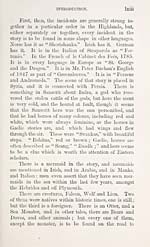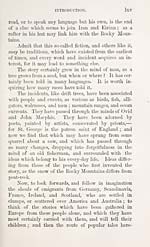Download files
Complete book:
Individual page:
Thumbnail gallery: Grid view | List view

IxÌY INTRODUCTION.
the land Avhere Sanscrit was spoken, and all these, and
luauy more, play their part in popular tales elsewhere,
Avhile no real animal is ever mentioned which is pecu-
liar to lands out of the road which leads overland to
India.
Nearly all these have Gaelic names, and most of
them are still living within a few days' journey of the
Hebrides under other names. I saw a live wolf from
a diligence one fine morning in Brittany, and I have
seen bears in Scandinavia and in Germany. The
only far-fetched animal is the Lion, and in another
story a similar creature appears as " Cu Seang." Here
is a fresh scent — for Sing is Lion in India — and viay
once have meant Lion in Gaehc; for though Leomh-
an is the word now used, Seang is applied to any-
tliing slender and active. Slmne is a dog in Sanscrit,
Siunnach a fox in Gaelic, and there are many other
Gaelic words which point to the " eastern origin of
Celtic nations." The story cannot have crossed the sea
from the West. It is therefore probable that it came
from the East, for it is not of home growth, and the
question is, how did it get to Barra ?
It seems to have been known along a certain track
for many ages. It is possible that it came from the
far East with the people, and that it has survived ever
since. It is hard to account for it otherwise. Those
who have most studied the subject so account for
popular tales elsewhere, and, therefore, John INIacphie's
story of the Sea-Maiden acquires an interest not all its
own.
Much has been Avritten, and said, and discovered
about the popular migrations which have poured from
East to West, and which are moving on still. Philo-
logy has mapped out the course of the human stream,
and here, in the mind of an old fisherman, unable to
the land Avhere Sanscrit was spoken, and all these, and
luauy more, play their part in popular tales elsewhere,
Avhile no real animal is ever mentioned which is pecu-
liar to lands out of the road which leads overland to
India.
Nearly all these have Gaelic names, and most of
them are still living within a few days' journey of the
Hebrides under other names. I saw a live wolf from
a diligence one fine morning in Brittany, and I have
seen bears in Scandinavia and in Germany. The
only far-fetched animal is the Lion, and in another
story a similar creature appears as " Cu Seang." Here
is a fresh scent — for Sing is Lion in India — and viay
once have meant Lion in Gaehc; for though Leomh-
an is the word now used, Seang is applied to any-
tliing slender and active. Slmne is a dog in Sanscrit,
Siunnach a fox in Gaelic, and there are many other
Gaelic words which point to the " eastern origin of
Celtic nations." The story cannot have crossed the sea
from the West. It is therefore probable that it came
from the East, for it is not of home growth, and the
question is, how did it get to Barra ?
It seems to have been known along a certain track
for many ages. It is possible that it came from the
far East with the people, and that it has survived ever
since. It is hard to account for it otherwise. Those
who have most studied the subject so account for
popular tales elsewhere, and, therefore, John INIacphie's
story of the Sea-Maiden acquires an interest not all its
own.
Much has been Avritten, and said, and discovered
about the popular migrations which have poured from
East to West, and which are moving on still. Philo-
logy has mapped out the course of the human stream,
and here, in the mind of an old fisherman, unable to
Set display mode to: Large image | Transcription
Images and transcriptions on this page, including medium image downloads, may be used under the Creative Commons Attribution 4.0 International Licence unless otherwise stated. ![]()
| Early Gaelic Book Collections > Blair Collection > Popular tales of the West Highlands > Volume 1 > (72) |
|---|
| Permanent URL | https://digital.nls.uk/76356062 |
|---|
| Description | Volume I. |
|---|---|
| Shelfmark | Blair.173 |
| Additional NLS resources: | |
| Attribution and copyright: |
|
| Description | Orally collected, with a translation by J.F. Campbell. |
|---|---|
| Shelfmark | Blair.173-176 |
| Additional NLS resources: | |
| Description | A selection of books from a collection of more than 500 titles, mostly on religious and literary topics. Also includes some material dealing with other Celtic languages and societies. Collection created towards the end of the 19th century by Lady Evelyn Stewart Murray. |
|---|
| Description | Selected items from five 'Special and Named Printed Collections'. Includes books in Gaelic and other Celtic languages, works about the Gaels, their languages, literature, culture and history. |
|---|

